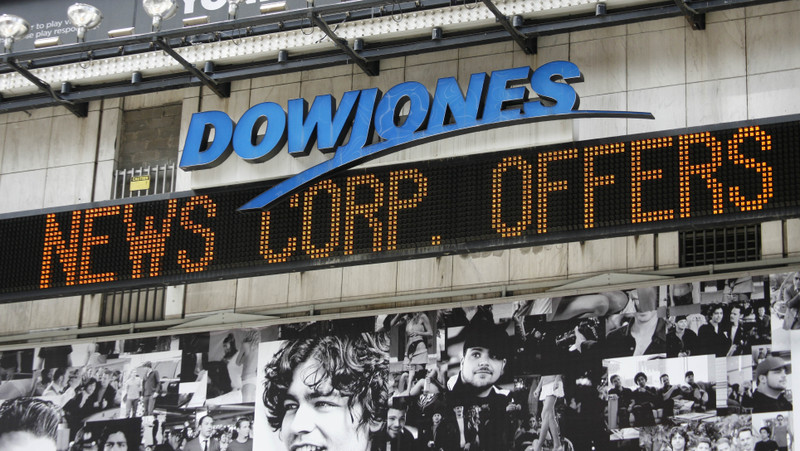
The Dow Jones Industrial Average jumped 347.51 points on the day to close at 25,309.99. The broader S&P 500 ended up 43.34 points, or 1.6%, at 2747.30, and the small-cap Russell 2000 19.20 points, or 1.25%, at 1549.19. The Nasdaq Composite gained 127.31 points, or 1.77%, to close at 7337.39.
For the week, the Dow closed up 0.36%, the S&P 500, 0.55%, the Russell 2000, 0.37%, and the Nasdaq, 1.35%.
The story—as usual—was about inflation, interest rates, and the Federal Reserve. Paving the way for the rally in stocks on Friday was a sharp slump in long-term interest rates, as markets took an increasingly benign view of the Fed’s latest pronouncements on when it will raise short-term rates and by how much. The yield on the key 10-year Treasury note fell 0.04 percentage point, to 2.87%. Earlier in the week, yields veered just south of the perilous 3.00% level.
Bonds are like seesaws: Their prices rise as their yield falls. Among stocks, so-called “bond proxies”—stable companies frequently owned for income—followed the bond market and prices rose. The S&P 500 Utilities Index rose 2.7% on the day, while the S&P 500 Real Estate Index gained 1.7%.
Energy stocks also rose on Friday, with the sector up 2.2% as oil prices gained. West Texas Intermediate crude oil rose 77 cents a barrel, to $63.54. The commodity was among the big winners of the week, ending up nearly 3% as U.S. inventory data came in below expectations.
Dow component and economic bellwether Walmart (WMT) failed again to attract bargain hunters, despite the stock’s hefty discount. It plunged early in the week on news of disappointing online sales. It closed Friday at $92.72, little changed but down more than 10% from a week ago.
Stocks End Volatile Week on a High Note
Hewlett Packard Enterprise (HPE) shot to the top of the S&P 500 on Friday, helped by its strong fiscal first-quarter earnings report. The stock rose $1.73, or 10.5%, to $18.14, getting a boost from its better-than-expected earnings and dividend increase.
HP Inc. (HP) also had a good day, climbing 3.5%. It was one of the S&P 500’s 25 best performers, as its own fiscal first-quarter easily topped expectations.
Hewlett Packard Enterprises has gained 26.3% year to date, although it’s fallen 26.8% over the past year. —Teresa Rivas
The Second Hottest Stock
Nordstrom (JWN) was the second-best performing stock in the S&P 500 on Friday, thanks to rumors that it’s finally lining up an agreement to go private.
Both Reuters and CNBC had articles out today citing sources close to the controlling family that it’s’ closing in on a deal to take the company private.
The news isn’t exactly a surprise. After all, the founding family has been trying to work out a go-private deal since last summer, news which periodically resurfaced over the months, and while it announced that it had halted its efforts in October, plenty of industry watchers had suspected that it was still working toward that end.
It’s easy to see why Nordstrom would want to go private. Amazon.com (AMZN) tore through retail like a tornado in recent years, and while Nordstrom has managed to become a leader in retail technology, it’s gotten little credit from shareholders, who worry about the cost and slow progress of Nordstrom’s long-term strategy. Going private would relieve Nordstrom of the quarterly scrutiny, as well as keep it from the tandem selloffs that many department store stocks have suffered amid negative headlines about mall traffic and trends.
Nordstrom closed up 6.5% to $53.56, and it’s gained more than 13% year to date.
The Biggest Loser
General Mills (GIS) slid to the bottom of the S&P 500, hurt by news of its acquisition of Blue Buffalo Pet Products (BUFF). The stock lost $1.97, or 3.6%, to $52.98. The packaged-food giant said it would buy Blue Buffalo for $40 a share in cash, in a deal valued at some $8 billion.
Stocks End Volatile Week on a High Note
While General Mills certainly is in need of a growth strategy, as it and other consumer-staples companies have languished, investors were concerned about aspects of the deal’s financing, including the fact that its net debt to earnings before interest, taxes, depreciation, and amortization will climb to 4.2 times and it will stop buying back its stock. Others are concerned that it’s paying too much for Blue Buffalo, whose stock has skyrocketed more than 60% in the past year. Blue Buffalo ended up 17.2% on the news, to $39.97.
General Mills is down 10.6% year to date, and has fallen 12.5% in the past year.

